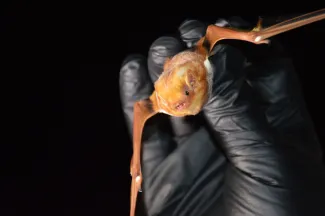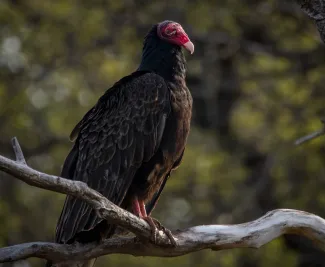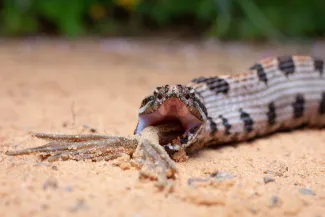Ecology – a branch of science that focuses on how organisms interact with each other and fit in their environment – shapes much of the Wildlife Department’s studies and management decisions. The incredible migrations of some fish and wildlife, the mysterious life histories of others, and the many jaw-dropping survival stories amaze us at every turn. We can’t help but share ecological stories of five eek-worthy species this Halloween season.

Invertebrates aren’t well-known for their extensive parenting skills; most employ a strategy that involves producing large numbers of offspring but providing little to no care. The expectation is that the fittest young will survive the odds without any additional investment of the adults. Wolf spiders, a family of spiders that actively hunts their prey instead of snaring food items in a web, deviate slightly from that loose rule.
Instead of using their spinnerets to spin webs, female wolf spiders use the structures to attach their egg sacs to their bodies. When the spiderlings are ready to hatch, the female makes a tear in the egg sac and dozens of young spiders emerge. They scramble onto the female’s back, layer upon layer, where they stay for at least a week. After that brief brooding period, spiderlings will move away from the female and begin hunting on their own.
Spider sightings – of the non-plastic variety – can be shared on free nature platforms like iNaturalist.

The eastern red bat may be Oklahoma’s most common bat, but its ability to disguise itself as a curled or dead leaf has presented undeniable challenges for ecologists who want to describe the winter habitat use of the species. This “tree bat” roosts among the leaves, with its furred tail wrapped around the body, and can be virtually undetectable. To study their habits, researchers have captured flying bats in specialized nets, attached small radio transmitters, and tracked the bats back to their roosts.
During colder periods, red bats may retreat to leaf piles that are 2.5-inches deep to better avoid the elements. While this tactic can be risky – a prescribed or natural fire may burn through the litter while the bats are in torpor – a study found the bats stirred at least two times faster with smoke and sounds of fire than they did without the fire cues.
Learn more about Oklahoma’s bat community in the Wildlife Department’s “Bats of Oklahoma Field Guide.”

One of Oklahoma’s most epic fish migration stories begins and ends in the Sargasso Sea, south of Bermuda. American eels hatch in the ocean and the willow-leaf-shaped larvae continue to develop as they float with the current to the Atlantic Coast. After arriving, the juvenile eels transform into their gray to greenish brown “elver” life form and move inland to more brackish waters. Eels continue moving inland and find freshwater homes in their next life stage. These “yellow” eels are nocturnal and can be found in Oklahoma’s rivers and streams. The snake-like fish begin to mature after 5 to 25 years and make a return trip to the sea where they spawn and are assumed to die.
Read about other migratory fish in our Outdoor Oklahoma Journal.

Decomposers like turkey vultures may not have the most glamorous ecological story, but these scavenging birds do have several traits that make them well-adapted to their eek-worthy role. Turkey vultures largely feed on wild or domestic carrion, with a slant toward dead mammals. The bald head helps keep feathers from fouling while the birds feed on decaying carcasses and the open sinuses may also help with post-meal cleanup.
Turkey vultures rely on their highly developed sense of smell to find food; once the carcass is found, the birds may gorge and then go days without feeding. The birds’ strong stomach acid helps with digestion and may lead to a resistance to bacteria and viruses that may be present in the carcasses turkey vultures feed upon.
Hear the turkey vulture’s formidable “hiss” and learn more about the birds with the Cornell Lab of Ornithology’s online guide.

Like most fish and wildlife, snakes can be found on both ends of the food chain, serving as predator and prey. Sometimes, they may even pretend to be prey to attract their next meal. Young western pygmy rattlesnakes have a yellow-tipped tail that can be raised and manipulated to mimic insect larvae or worms. When a frog, lizard, or any other interested “predator” investigates, the rattlesnake turns the tables with a venomous strike.
The yellow tail darkens with age and coincides with a shift in diet. Adult pygmy rattlesnakes tend to feed on larger prey like rodents and other snakes, for which the lure is less effective.
Learn more about Oklahoma’s amphibians and reptiles in the Wildlife Department’s custom-made field guide.